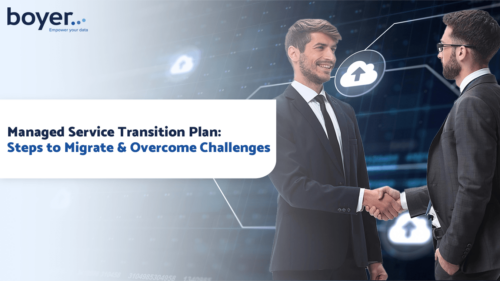It’s common to see organizations increasingly turning to managed services to streamline their operations and enhance efficiency.
However, the transition from traditional IT infrastructure to a managed service model can present its fair share of challenges.
This article explores the key steps involved in a managed service transition plan, as well as strategies to overcome potential hurdles.
By following these steps, organizations can successfully migrate to managed services and achieve the freedom they desire in their business operations.
Key Takeaways
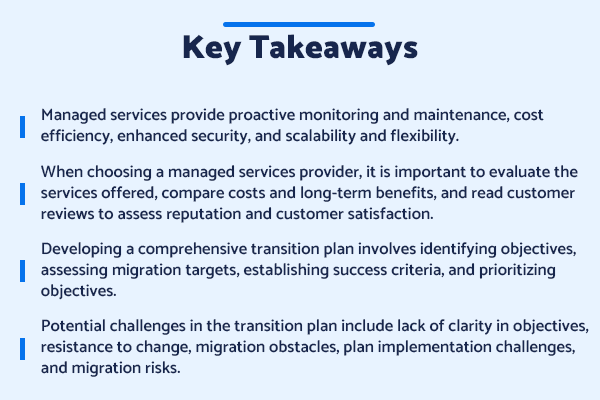
- Managed services provide proactive monitoring and maintenance, cost efficiency, enhanced security, and scalability and flexibility.
- When choosing a managed services provider, it is important to evaluate the services offered, compare costs and long-term benefits, and read customer reviews to assess reputation and customer satisfaction.
- Developing a comprehensive transition plan involves identifying objectives, assessing migration targets, establishing success criteria, and prioritizing objectives.
- Potential challenges in the transition plan include lack of clarity in objectives, resistance to change, migration obstacles, plan implementation challenges, and migration risks.
Understanding Managed Services
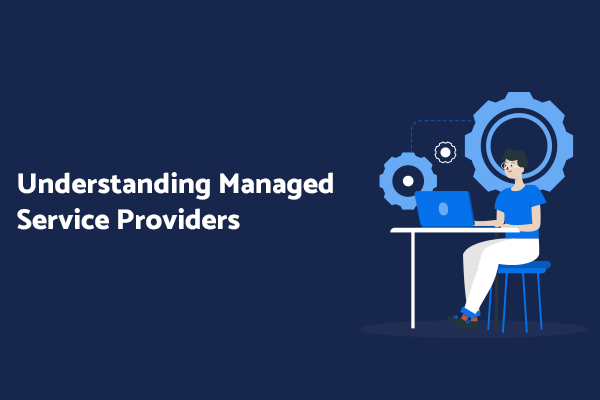
To effectively transition to managed services, it is important to have a clear understanding of what managed services are and the benefits they offer.
Managed services can be defined as the outsourcing of software management to a third-party provider, who takes responsibility for monitoring, managing, and maintaining these functions.
Managed Services Defined
Managed services are outsourced Microsoft business application solutions that provide proactive management and support for a company’s technology infrastructure. As businesses face increasing complexities in their Microsoft business apps, managed services have become a popular choice for organizations looking to streamline their operations and focus on core business activities.
Here are four key aspects of managed services that make them an attractive option for companies:
- Proactive Monitoring and Maintenance: Managed service providers proactively monitor systems, identify potential issues, and address them before they become major problems.
- Cost Efficiency: By outsourcing software management, companies can reduce costs associated with hiring and training an in-house IT team, as well as investing in expensive hardware and software.
- Enhanced Security: Managed service providers implement Microsoft business apps and their full capability of robust security measures to protect sensitive data and prevent cyber threats.
- Scalability and Flexibility: Managed services optimize Microsoft business applications to allow businesses to easily scale their infrastructure up or down based on their changing needs, providing the freedom to adapt to market demands.
Implementing managed services can bring numerous benefits, but it is important to be aware of the challenges that may arise during the transition. Boyer can make the transition as smooth as possible. We are a trusted Microsoft partner ready to implement our expertise.
Benefits of Managed Services
One advantage of using managed services is the improved efficiency and focus on core business activities. By outsourcing software management, businesses can free up valuable resources and personnel to concentrate on their core competencies.
Managed services providers (MSPs) have the expertise and tools to efficiently manage and monitor software operations, reducing the risk of downtime and maximizing productivity. Additionally, MSPs offer proactive maintenance and support, ensuring that potential issues are detected and resolved before they become major problems.
Another benefit is cost savings. Instead of investing in expensive hardware and software, businesses can leverage the resources of the MSP, paying only for the services they need.
Choosing a Provider
When considering managed services, it is essential to carefully select a provider that aligns with your business needs and goals.
Here are four key steps to help you make an informed decision:
- Provider Selection: Begin by evaluating your options and creating a shortlist of potential providers. Look for providers that specialize in your industry and have a track record of success.
- Comparing Services: Once you have a shortlist, compare the services offered by each provider. Consider factors such as service level agreements, response times, and the range of services provided.
- Cost Analysis: Evaluate the cost of each provider’s services and determine if it fits within your budget. Be sure to consider the long-term benefits and potential cost savings that managed services can provide.
- Customer Reviews: Finally, read customer reviews and testimonials to gain insights into the provider’s reputation and customer satisfaction. This will give you a better understanding of their reliability and quality of service.
At Boyer & Associates, we offer customizable plans so that you can subscribe to managed services specific to your company’s needs.
Developing a Comprehensive Transition Plan
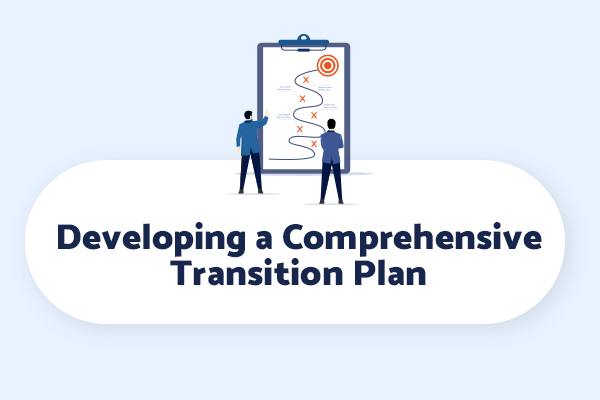
When developing a comprehensive transition plan for managed services, it is crucial to first identify the transition objectives to ensure a clear direction. This includes outlining the necessary plan components such as timelines, resources, and key deliverables.
However, it is important to anticipate potential challenges that may arise during the transition process in order to proactively address them and minimize any disruptions to the business operations.
Identifying Transition Objectives
To develop a comprehensive transition plan, it is crucial to clearly identify the transition objectives. Setting goals and determining the desired outcomes will provide a clear direction for the migration process. Here are four key steps to consider when identifying transition objectives:
- Define Transition Objectives: Clearly articulate the purpose and goals of the transition. This includes identifying the specific outcomes and benefits that the organization aims to achieve.
- Assess Migration Targets: Evaluate the existing system and identify the components, applications, and processes that need to be migrated. This will help in determining the scope and complexity of the transition.
- Establish Success Criteria: Define measurable criteria that will determine the success of the transition. These criteria should align with the organization’s strategic objectives and provide a clear benchmark for evaluating progress.
- Prioritize Objectives: Rank the transition objectives based on their importance and impact on the organization. This will help in allocating resources and prioritizing tasks during the transition process.
Outlining Plan Components
To develop a comprehensive transition plan, it is important to outline the key components that will guide the process. These plan components include:
- Identifying the specific transition challenges that need to be addressed.
- Defining the migration goals.
- Establishing a clear plan for the migration process.
Additionally, it is crucial to consider resource allocation issues. This involves:
- Identifying the necessary resources.
- Allocating them effectively to ensure a smooth transition.
Potential Plan Challenges
Developing a comprehensive transition plan for a managed service entails considering potential plan challenges that may arise during the process. Migration obstacles, transition difficulties, plan implementation challenges, and potential migration risks are all factors that need to be addressed in order to ensure a smooth and successful transition.
Here are four key challenges that organizations may face when developing a managed service transition plan:
- Lack of Clarity: Unclear objectives and expectations can lead to confusion and hinder progress during the transition process.
- Resistance to Change: You might need to overcome resistance from employees and stakeholders who may be hesitant to adopt new processes or technologies.
- Resource Constraints: Limited resources, such as time, budget, and skilled personnel, can pose challenges in implementing the transition plan effectively.
- Data Security and Privacy Concerns: Ensure data security and privacy throughout the transition process to mitigate potential risks and comply with regulatory requirements.
Key Steps in the Migration Process
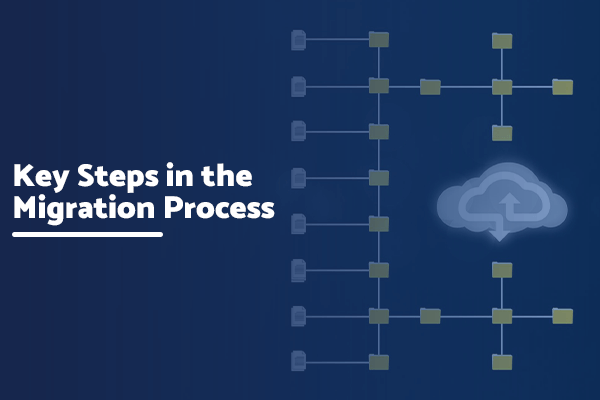
The first step is to identify the migration goals, which involves understanding what the business aims to achieve through the migration.
The second step is to plan the migration strategy, which includes determining the timeline, resource allocation, and potential risks.
Lastly, the third step is to implement the migration plan, which involves executing the necessary tasks and ensuring a smooth transition.
Identifying Migration Goals
One of the key steps in the migration process is to clearly define the migration goals. This step is crucial as it provides a clear direction for the entire migration project. By setting objectives and identifying migration goals, organizations can ensure that their efforts are focused and aligned with their desired outcomes.
Here are four important considerations when it comes to identifying migration goals:
- Define the Purpose: Clearly articulate the reasons behind the migration and what the organization hopes to achieve by migrating to a new service. This will help in aligning the efforts towards a common goal.
- Prioritize Objectives: Determine the most important objectives that need to be achieved through the migration process. This will help in allocating resources and planning the migration strategy effectively.
- Set Measurable Goals: Ensure that the migration goals are specific, measurable, achievable, relevant, and time-bound (SMART). This will enable organizations to track their progress and evaluate the success of the migration project.
- Involve Stakeholders: Engage key stakeholders in the goal-setting process to ensure their perspectives and requirements are considered. This will foster collaboration and increase the likelihood of achieving the desired outcomes.
Implementing Migration Plan
Continuously implementing the migration plan is essential for a successful transition to a managed service, ensuring a seamless and efficient process. To effectively implement the migration plan, the following key steps should be followed:
- Develop an Implementation Timeline: Create a detailed timeline that outlines the specific tasks, milestones, and deadlines for each phase of the migration process. This will help keep the project on track and ensure that all activities are completed within the designated time frame.
- Utilize Migration Tools: Utilize appropriate migration tools and technologies to facilitate the smooth transfer of data and applications from the existing infrastructure to the managed service environment. These tools can help automate the migration process, reducing manual effort and minimizing the risk of errors.
- Execute Data Migration: Transfer data from the current environment to the new cloud managed service platform, ensuring data integrity and security. This involves mapping and validating data, performing data cleansing if necessary, and verifying the accuracy of the migrated data.
- Maintain Stakeholder Communication: Continuously communicate with all stakeholders involved in the migration process, including end-users, IT teams, and management. Regular updates and clear communication channels will help manage expectations, address concerns, and ensure a smooth transition.
Once the migration is complete, it is crucial to conduct a post-migration evaluation. Assess the effectiveness of the migration plan, identify any issues or areas for improvement, and gather feedback from stakeholders. This evaluation will help refine future migration strategies and ensure a successful transition to the managed service.
Identifying Potential Migration Challenges

When it comes to migrating to a managed service model, it is crucial to identify the potential challenges that may arise. Recognizing migration risks allows businesses to proactively address them and minimize their impact on the transition process.
Additionally, predicting resource allocation issues and understanding compatibility concerns are essential for a smooth and successful migration. By acknowledging these challenges upfront, organizations can develop effective strategies to overcome them and ensure a seamless transition to a managed service.
Recognizing Migration Risks
The identification of potential migration challenges is crucial in recognizing migration risks during the managed service transition plan. To ensure a smooth and successful migration, it is important to take a proactive approach and be prepared for any obstacles that may arise.
Here are four common challenges to consider and strategies for risk mitigation:
- Data Migration: Ensuring the accurate and secure transfer of data from the legacy system to the new environment requires careful planning and validation.
- Compatibility Issues: Addressing compatibility issues between different systems and applications is essential to avoid disruptions or functionality gaps during the transition.
- Stakeholder Resistance: Overcoming resistance from employees or stakeholders who are resistant to change requires effective communication, training, and involvement in the migration process.
- Downtime and Service Disruption: Minimizing downtime and service disruptions during the migration requires thorough testing, backup plans, and a well-defined rollback strategy.
Predicting Resource Allocation Issues
An essential step in the managed service transition plan is identifying potential migration challenges, including predicting resource allocation issues. Resource planning plays a crucial role in ensuring a smooth transition from one service provider to another.
Capacity forecasting helps estimate the resources required during the migration process, enabling organizations to allocate them effectively. Resource management involves efficiently utilizing available resources, minimizing waste, and optimizing usage. Demand estimation assists in determining the expected resource needs, considering factors such as workload, growth projections, and user requirements.
Understanding Compatibility Concerns
Continuing the discussion from predicting resource allocation issues, organizations must delve into understanding compatibility concerns as they identify potential migration challenges in their managed service transition plan. Compatibility testing plays a crucial role in ensuring a smooth migration process. Here are four key points to consider:
- Software Integration: Assess the compatibility of existing software with the new Microsoft business applications to ensure seamless integration and avoid any disruptions in operations.
- Hardware Requirements: In the case of Microsoft business applications, a cloud system replaces any hardware infrastructure.
- Application Dependencies: Identify any dependencies between applications and ensure they are compatible with Microsoft business applications. Addressing any conflicts or dependencies is essential for a successful migration.
Strategies to Overcome Transition Hurdles

Overcoming transition hurdles is a critical aspect of a successful managed service transition plan.
To do so, it is essential to first identify potential hurdles that may arise during the migration process.
Once these hurdles are identified, organizations can develop and implement effective migration strategies to address and overcome these challenges.
Effective Migration Strategies
To successfully navigate the managed service transition process and overcome potential hurdles, organizations can implement effective migration strategies.
Efficient data migration is crucial to ensure that valuable information is transferred accurately and securely. This involves analyzing and categorizing data, as well as using appropriate tools and techniques for data transfer.
Seamless application transition is another key aspect, which involves careful planning and testing to ensure that applications are smoothly moved from one environment to another.
Streamlined infrastructure migration is essential for a successful transition. It involves assessing and optimizing the existing infrastructure to ensure compatibility and performance in the new environment.
Additionally, organizations should focus on effective migration planning, which includes setting clear objectives, creating a detailed timeline, and involving all relevant stakeholders.
Successful cloud migration can be achieved by leveraging cloud services and providers that align with the organization’s needs and requirements.
Frequently Asked Questions

What are the benefits of implementing a managed service transition plan?
Implementing a managed service transition plan offers numerous benefits, including improved efficiency, cost savings, enhanced service quality, reduced risk, and access to specialized expertise. It allows organizations to focus on core competencies while delegating IT management to experts.
What factors should be considered when identifying potential migration challenges?
When identifying potential migration challenges, it is important to consider various factors such as migration risks, potential obstacles, and critical success factors. Conducting a thorough risk assessment and implementing effective mitigation strategies can help overcome these challenges.
Are there any specific strategies or best practices for overcoming transition hurdles?
When it comes to overcoming transition hurdles in managing service transitions, there are various strategies and best practices that can be employed. These include thorough planning, effective communication, stakeholder engagement, and continuous monitoring and evaluation.
What are some common pitfalls to avoid during the migration process?
During the migration process, common pitfalls to avoid include inadequate change management, lack of communication, insufficient planning, data migration issues, and the risk of vendor lock-in. These challenges can be mitigated through careful planning and proactive communication.
Embrace Change with Managed Services
In conclusion, a well-developed managed service transition plan is crucial for a successful migration process.
By understanding the concept of managed services and implementing a comprehensive transition plan, organizations can effectively navigate through the challenges that may arise during the migration process.
By identifying potential migration challenges and employing appropriate strategies to overcome them, businesses can ensure a smooth transition to a managed service model and reap the benefits it offers.
Ready to transform your business with the right software solution? It’s time to choose a partner who truly understands your needs. At Boyer & Associates, we believe in a balanced approach to software implementation. Our team of experts knows that your business is unique, and we’re committed to finding the sweet spot between a one-size-fits-all solution and a completely customized one.
Why settle for a generic implementation or an over-complicated, costly system? Let Boyer & Associates guide you through a seamless integration of Microsoft Dynamics, tailored to fit your business like a glove. Our approach is designed to be efficient, cost-effective, and sustainable for the long haul.
Contact Boyer & Associates today. Let’s discuss how we can make your software implementation a perfect fit for your business’s unique journey. Transform your operations with a partner who understands balance is key. Choose Boyer & Associates – where your business needs meet expert solutions.


